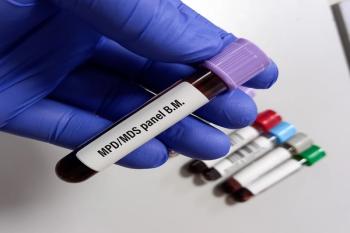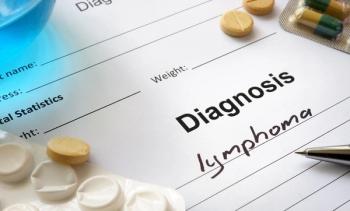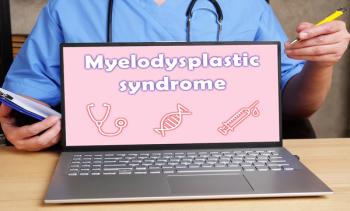
The FDA first approved eculizumab for use in adult patients with generalized myasthenia gravis in 2017, before expanding the indication to include pediatric patients who are 6 years or older and positive for antiacetylcholine receptor antibodies.

The FDA first approved eculizumab for use in adult patients with generalized myasthenia gravis in 2017, before expanding the indication to include pediatric patients who are 6 years or older and positive for antiacetylcholine receptor antibodies.





There’s a balance required to manage both the symptoms of myelofibrosis through treatment and the side effects caused by the drugs, explained Firas El Chaer, MD, of the University of Virginia School of Medicine.

In addition to new treatments over the past few years changing the landscape for patients, additional treatments being evaluated are looking at new mechanisms of action, said Firas El Chaer, MD, of University of Virginia School of Medicine.

Experts discussed the great advances and innovations they’ve seen this year in acute myeloid leukemia (AML) and multiple myeloma.

Bispecific antibodies show strong initial uptake in community settings for multiple myeloma treatment, particularly among Black patients compared with clinical trials.

By reducing cytokine release syndrome and neurotoxicity, prophylactic tocilizumab could facilitate safe outpatient administration of bispecifics to treat multiple myeloma (MM), explained Robert Rifkin, MD.

A shorter duration of venetoclax treatment for newly diagnosed acute myeloid leukemia (AML) may enhance efficacy and reduce toxicity, according to Amir Ali, PharmD, BCOP.

The SEQUOIA study's 5-year follow-up confirms zanubrutinib's safety profile and low cardiovascular events in treatment-naive chronic lymphocytic leukemia, according to Mazyar Shadman, MD, MPH, of Fred Hutchinson Cancer Center.

Severity of a COVID-19 illness could be determined by examining autoantibodies in the nasal cavity, allowing more personalized treatment protocols.

The treatment showed effectiveness in achieving local control of acute myeloid leukemia (AML) that developed in the eyes of a pediatric patient.

Although an aerobic cooldown indeed lowers blood glucose levels in adults with type 1 diabetes after fasted exercise, by itself, the impact it has on hyperglycemia is insignificant.

Hemoglobin levels, transfusion independence, and low serum erythropoietin levels were all deemed to have a statistically significant relationship with erythropoiesis-stimulating agent (ESA) response.

Matching-adjusted indirect comparison methodology was utilized to compare ibrutinib arms across the ALPINE and ELEVATE-RR trials.

Due to the rarity of primary breast lymphoma, individualized treatment plans that consider overall health, symptoms, and patient preferences should be curated.

Due to often being overlooked as only carriers of hemophilia, the review authors sought to highlight the needs of female caretakers for patients with the disorder and the possibility of women themselves being affected by it.

In patients living with HIV, the cardiovascular risk factors that come with infection may lead to an increased prevalence of coronary artery stenosis, especially in those who also have hemophilia.

Consistent with previous observations, overall survival and progression-free survival remained strong at the follow-up point.

There was a marked increase in the prevalence of targeted therapy among patients with chronic lymphocytic leukemia (CLL), which corresponded to positive overall survival rates observed in the study.

Population pharmacokinetic and exposure-response analyses revealed a favorable benefit-risk profilane for the treatment combination of polatuzumab vedotin and rituximab, cyclophosphamide, doxorubicin, and prednisone (R-CHP).

A series of case studies reveals the importance of early diagnosis and involvement of special teams of clinicians when dealing with potential cases of overlap syndrome, which encompasses myocarditis, myasthenia gravis, and immune checkpoint inhibitor–related myositis.

The connection was primarily established between type 1 diabetes (T1D) and the eating disorders bulimia and binge eating, with female patients with T1D at higher risk of insulin misuse as a result.

Using the newly created MAESTRO-Pool tool, whole genome sequencing revealed DNA that could be used to more effectively detect minimum residual disease (MRD) in patients who have diffuse large B-cell lymphoma (DLBCL).

The rate of relapse among patients with TP53-mutated myelodysplastic syndrome (MDS) or acute myeloid leukemia (AML) was similar among those who underwent allogeneic hematopoietic stem cell transplant vs those who did not.

Positive responses seen following experiments involving metastasis-associated in colon cancer 1 (MACC1) indicate that the biomarker can be used to better diagnose and treat patients with pulmonary arterial hypertension (PAH).

Overall survival and complete response rates were comparable across a younger and an older cohort of patients with relapsed/refractory diffuse large B-cell lymphoma (DLBCL).

This study builds on previous evidence for lenalidomide-induced selective advantage for TP53-mutant clones.

Published: January 3rd 2025 | Updated:

Published: January 6th 2025 | Updated:

Published: December 16th 2024 | Updated:

Published: March 15th 2025 | Updated:

Published: December 8th 2024 | Updated:

Published: February 4th 2024 | Updated:

259 Prospect Plains Rd, Bldg H
Cranbury, NJ 08512
© 2025 MJH Life Sciences®
All rights reserved.
